Seven Pilgrimages to the Ship’s Gravesite
Little did I know, then, that I would eventually make seven pilgrimages to the ship’s gravesite and actually board her three times. In retrospect, an Ameri-Odyssey!
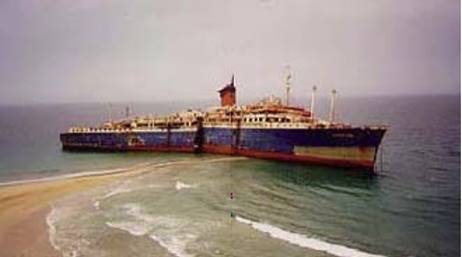 On
19 November, 1994, after a four and a half hour flight, we landed on
Fuerteventura Island. The next day we made enquiries about the terrain
on the part of the island where the ship had gone ashore. The consensus
was that we would have to use a four-wheel drive vehicle, as the vessel
was located at the end of an unidentified track in extremely rough country.
In addition, we were told that the ship was beached in a military area,
causing me to fear that our Greek experience in 1984 might be repeated.
On
19 November, 1994, after a four and a half hour flight, we landed on
Fuerteventura Island. The next day we made enquiries about the terrain
on the part of the island where the ship had gone ashore. The consensus
was that we would have to use a four-wheel drive vehicle, as the vessel
was located at the end of an unidentified track in extremely rough country.
In addition, we were told that the ship was beached in a military area,
causing me to fear that our Greek experience in 1984 might be repeated.
I need not have worried. We soon learned that the ship had been of great interest to the islanders when she first grounded. People had been able, during calm weather, to reach the vessel, board her and conduct extensive salvage operations. We were told that during low tide on a calm day, it was possible to walk out on a sand bar and get very close to the ship.
Nevertheless, close as it seemed, attempting access to the remains of the ship from that sandbar was not safe. We were told that the swirling waters in between the sand and the side of the ship had already claimed at least one life.
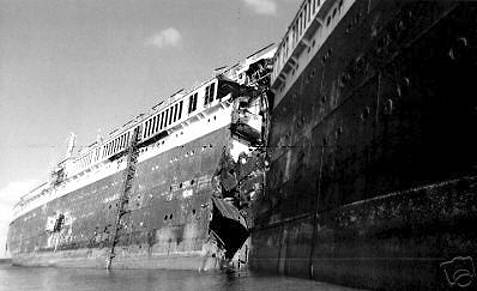 With
that information in mind, we rented a four-wheel drive vehicle, and
set off to find the ship.
With
that information in mind, we rented a four-wheel drive vehicle, and
set off to find the ship.
Since neither my wife, Ann, nor I spoke Spanish, we drew a sketch of the two halves of the ship, and showed it to people along the way. One of them gave us a crude map to follow, drawn on a torn and tattered piece of cardboard. Wandering about somewhat aimlessly, Ann chanced to look down and over to the left, through a gap in the mountainous terrain. There, in the distance, way below us, her elegant lines still beautiful, was MY ship.
Her remaining, red funnel was clearly visible, as was the blue hull and white superstructure, with her bridge structure painted a garish orange. Nevertheless, she was a lovely sight to behold. Anxiously, we tried various approaches to the beach area, at one point coming up to a wired off areas that had signs indicating the area was mined!
Eventually, we found the right path and soon found ourselves on a bluff, overlooking the wreck site. The fatal break in her hull was clearly visible, but even this, coupled with rust marks and fire damage, did not detract from her innate and timeless beauty. She once more captured my emotions, bringing to mind happy days onboard AUSTRALIS.
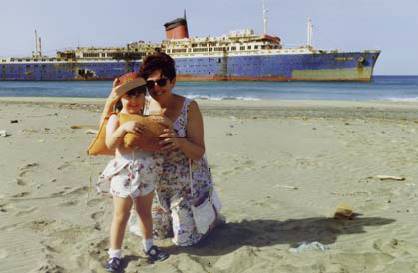 The
beach was sandy but scattered with stones. The scavengers had picked
it clean of spoils, except for a few odd fragments. However, one of
them must have dropped a child’s life preserver, which I found,
stained with seawater marks and salt, near a small outcrop of rock and
mud. It had the name AMERICA on one side, and her later name of ITALIS
on the other.
The
beach was sandy but scattered with stones. The scavengers had picked
it clean of spoils, except for a few odd fragments. However, one of
them must have dropped a child’s life preserver, which I found,
stained with seawater marks and salt, near a small outcrop of rock and
mud. It had the name AMERICA on one side, and her later name of ITALIS
on the other.
Our four year-old daughter, Sarah tried it on for size and modeled for me, with her Mother’s assistance, with the shipwreck in the background. Afterwards, we carefully wrapped it in plastic bags (to seal in the smell!) and took it home in our luggage as a poignant souvenir.
The next day, we set off again just as the eastern sky started to turn rose pink. When we got to the wreck site, the wind was at gale force. The waves crashed; the wind whistled. I made my way, with some difficulty, to a nearby headland to photograph the scene. There, I was quite alone with my thoughts, the only noise being that of the wind and the crashing waves. There was no sound of birds, of people, of traffic or of leaves rustling. The combination enveloped my senses.
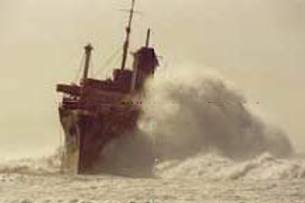 Even
after hours there at the wreck site, it was hard to finally make the
decision to leave, but time and tide waits for no man. Taking a final,
long look at my beautiful, broken Australian Maiden, I turned the jeep
around and away from the shore.
Even
after hours there at the wreck site, it was hard to finally make the
decision to leave, but time and tide waits for no man. Taking a final,
long look at my beautiful, broken Australian Maiden, I turned the jeep
around and away from the shore.
We stopped at a distance for a few seconds for a final glance. By the time we reached the tarmac of the main road, the sun was setting, and it already seemed as if it had all been but a dream.
Upon our return to England, I very quickly became unsettled with the feeling that I had unfinished business to attend to in Fuerteventura. Would it be possible to hire a boat to take me to the seaward side of the wreck to see how much damage wind and wave had inflicted since she went aground? An even more exhilarating thought developed in my mind. Could I, or dare I, try to get on board and walk her decks once again? The allure of those possibilities was inescapable.
Back again: The First Boarding ...
Seven months later, we went back to Fuerteventura Island, and headed for a fishing port that was nearest to the AMERICAN STAR. In time, mentioning the words American Star, together with gestures to boats, the distant horizon and my camera, seemed to do the trick. We met a young man who had a small boat and who had been on the wreck several times. He and a friend agreed to help me get onboard the ship. It was my wildest dream come true and surpassed all expectations of what I had hoped for when I left England. At best, I had thought I might be able to hire a boat to circle the wreck, but to go on board again after almost twenty years had seemed an impossible desire.
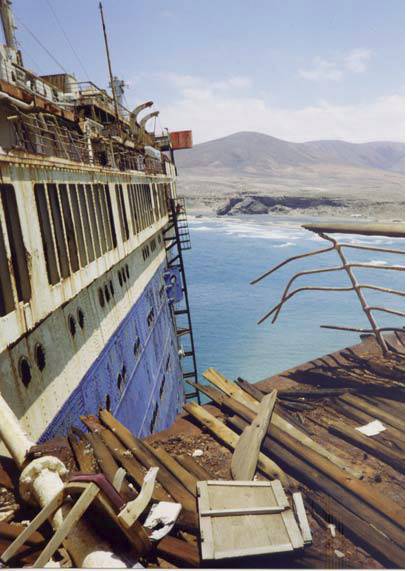 Quickly
bidding goodbye to my wife and daughter, I set off into the hot afternoon
sun. As we walked towards my newfound friend’s boat, I almost
reeled over with shock. It was only the size of a small rowing boat;
barely big enough for three people and powered with but a small, single
outboard motor! I nearly refused to go, but realizing it might be my
only opportunity to ever board the wreck, I helped push the boat down
the beach, and against my better judgment, climbed in.
Quickly
bidding goodbye to my wife and daughter, I set off into the hot afternoon
sun. As we walked towards my newfound friend’s boat, I almost
reeled over with shock. It was only the size of a small rowing boat;
barely big enough for three people and powered with but a small, single
outboard motor! I nearly refused to go, but realizing it might be my
only opportunity to ever board the wreck, I helped push the boat down
the beach, and against my better judgment, climbed in.
It took almost two hours to reach the AMERICAN STAR. We made our way carefully to the base of the ladder on the forward section of the wreck, starboard side. This crude metal ladder had been welded in place for use by the towing crew. We moored our little craft to the lowest rung. To my shock, I was told to go up the ladder first.
The climb was about 70 feet. Thankfully, the ladder was sturdy and securely welded into place, but still a daunting climb to the unaccustomed and unfit. I did not look anywhere but upwards and concentrated on gaining access through one of the Promenade Deck window frames.
This picture, which I took after we got safely onboard, provides some indication of the difficulty, and scary nature of that climb. It also depicts the dramatic results of the ship breaking in two, and the badly damaged sections in fatal misalignment.
Standing there, I had the very real feeling of possibly falling over the edge; pushed by the howling wind. I did not tarry long there.
When I first stepped off that ladder, I mentally stepped back in time. The Promenade Deck had been a light, airy space, stretching the whole length of the ship, and lined with highly polished brass-trimmed windows and teak railings. However, reality quickly overwhelmed my daydreams. Sadly foreshortened by the break in the hull, every window and railing on that long, lovely promenade was gone. The wind whistled through empty window frames. The deck was strewn with chunks of wood, glass and twisted metal.
Near the break, one of my companions managed to snap this picture
of me by leaning precariously out of one of the windowless Promenade
Deck openings. We went from space to space, deck to deck, taking photographs
of what little remained of the ship’s former beauty. We went as
far down as C Deck, to see
the swimming pool, and as far topside
as the bridge. We even ventured into the aft section, another adventure
that involved stepping across a rough-edged abyss ...
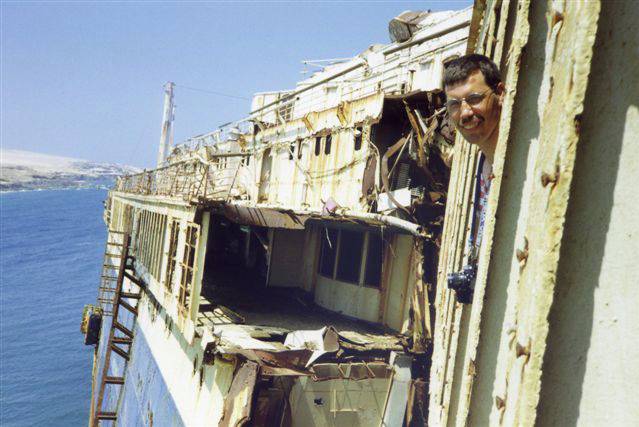
We also explored once-elegant public spaces; utterly devastated by the forces of nature and the greed of man. A favorite that had first thrilled me in 1974 was the beautiful main lounge; shown here as it looked when I first saw it.
Below, in stark contrast, is what this same space looked like when I last visited it. Stripped of its finery, there was virtually, nothing remaining except a structural skeleton, all in shadow.
Other spaces visited sadly appeared much the same. If ever there was such a thing as a haunted ship, this was it. Darkness abounded, and strange shapes loomed out of the shadows. Eerie sounds were also present. I know that those were the results of the wreck’s continuous process of decline; nevertheless ...
All too soon, it was time to leave. It was an amazing experience, one that I shall remember all my life.
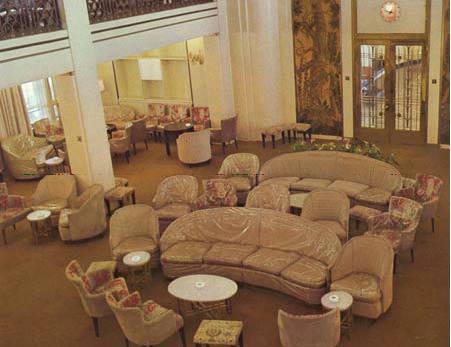 |
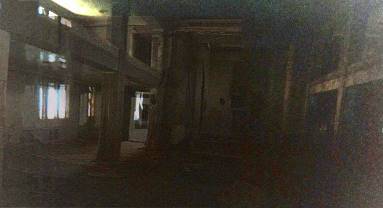 |
Returning to the point of our departure, and the company of my anxious wife and small daughter, I displayed a few small artifacts that I had managed to collect while onboard the wreck. The locals were intrigued by our activity and the reason why I had wanted to visit the AMERICAN STAR. They were very interested in what I had retrieved and solemnly passed the items around for inspection.
I had amassed a few keys from the purser’s office, a safety deposit box complete with a note as to the last user, and a length of brass my companions had pried from a pillar in the lounge. The most treasured prize of all, though, was a section of handrail with brass end-pieces; once strategically positioned to provide access to lowered lifeboats. It was quite weathered; the teak dull and unvarnished, the brass green with the salt of the sea.
While sailing in AUSTRALIS, I had observed how the crew took great care to dust and polish the vast lengths of railings every day. I had often leaned on those rails and daydreamed, and it seemed incredible that I now had a section of that same railing all my very own. Since my hobby is woodworking, I have been able to create some unique artifacts honoring MY ship, utilizing such pieces of her very existence.

Today, fully restored and further adorned with the ship’s original name, which I hand-carved and then painted; this treasure resides in a prominent place in my home as a vivid memory of my first time onboard the stricken ship ...
© 2008 Steve Tacey